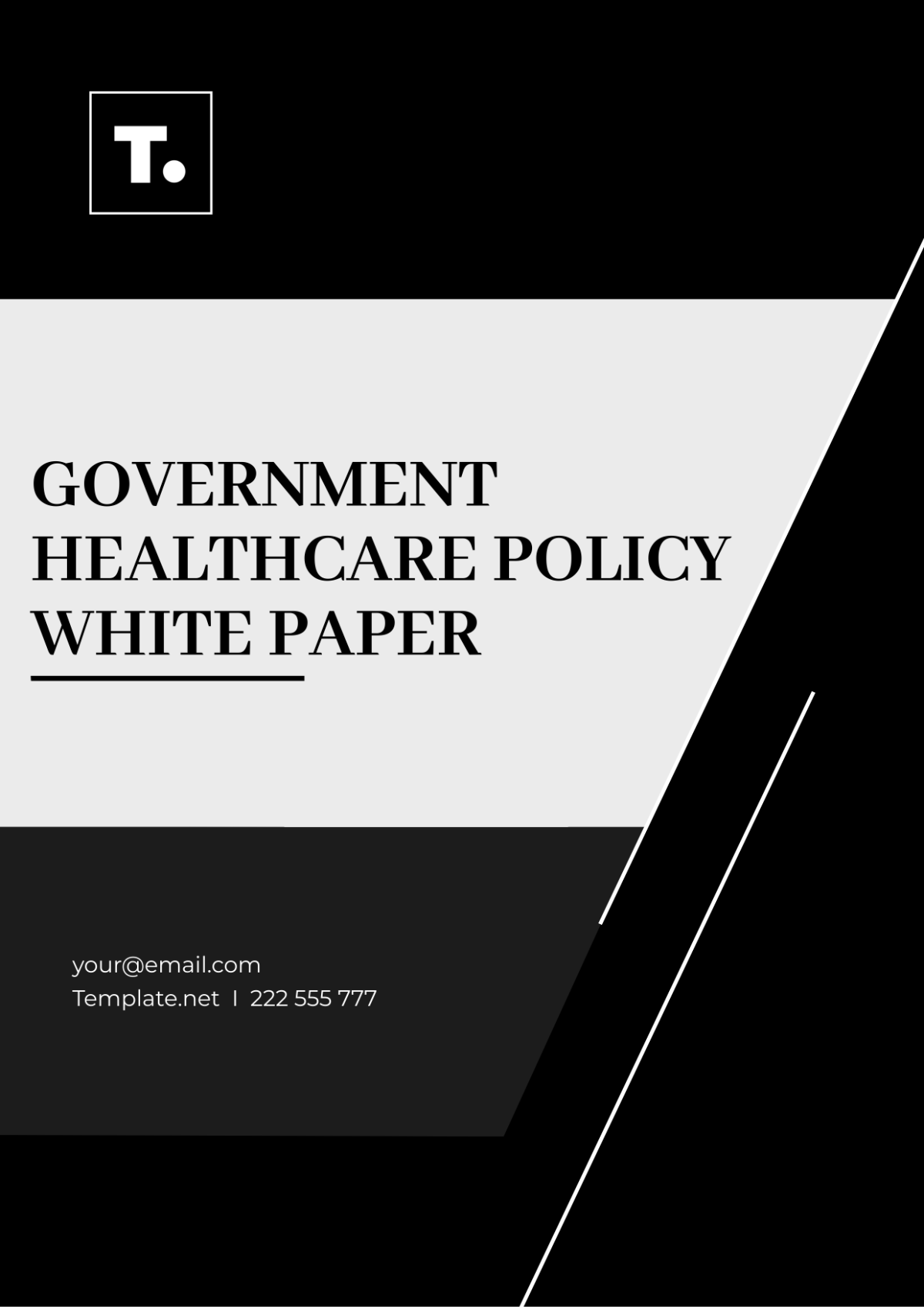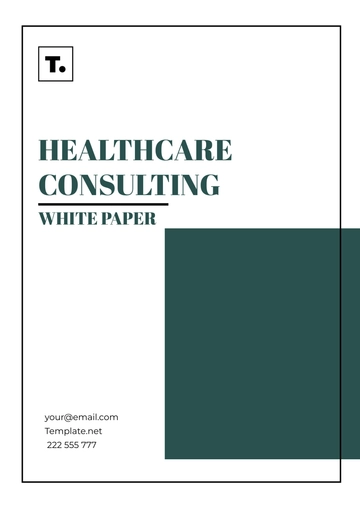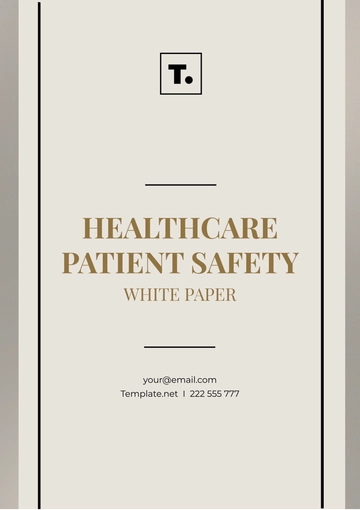Free Government Healthcare Policy White Paper

Prepared by: [YOUR NAME]
Date: [DATE]
Prepared for: [RECIPIENT NAME]
Department: [YOUR DEPARTMENT]
I. Executive Summary
The Healthcare Solutions Corporation Healthcare Policy White Paper presents an in-depth analysis of critical issues within the healthcare sector. This document aims to provide a comprehensive overview of healthcare systems, regulatory frameworks, funding mechanisms, and access to healthcare services. Through evidence-based research and stakeholder consultation, this white paper identifies key challenges and proposes policy recommendations to enhance healthcare quality, affordability, and equity.
II. Introduction
In this section, Healthcare Solutions Corporation warmly welcomes readers to delve into the critical analysis and proposals presented in this white paper. With a shared commitment to improving healthcare systems and outcomes, this document serves as a beacon of insight and action.
A. Prelude to Progress
The healthcare landscape is complex and ever-evolving, shaped by a multitude of factors ranging from technological advancements to socioeconomic disparities. As such, it is imperative to embark on a journey of understanding and innovation, seeking solutions that transcend conventional boundaries.
B. Unveiling the Purpose
At the heart of this white paper lies a steadfast commitment to unraveling the intricacies of healthcare policy formulation and implementation. By shedding light on the current state of affairs and envisioning a path forward, we aim to catalyze meaningful change and foster a healthcare ecosystem that is equitable, accessible, and sustainable.
C. The Guiding Objectives
Throughout the pages that follow, our primary objectives are clear:
To conduct a comprehensive analysis of healthcare systems, regulatory frameworks, funding mechanisms, and access to healthcare services.
To identify key challenges and opportunities within the healthcare landscape, grounded in evidence-based research and stakeholder insights.
To propose actionable policy recommendations aimed at enhancing healthcare quality, affordability, and equity, driving tangible improvements for individuals and communities alike.
III. Current State of Healthcare Systems

A. Healthcare Infrastructure and Resources
1. Hospitals and Facilities
Description of existing healthcare facilities, including hospitals, clinics, and specialized centers, across urban and rural areas.
Analysis of infrastructure gaps and areas for improvement, such as outdated equipment or insufficient bed capacity, with case studies illustrating specific challenges.
2. Medical Personnel
Overview of the healthcare workforce, including doctors, nurses, and allied health professionals, examining workforce demographics and distribution.
Evaluation of staffing levels and distribution, highlighting shortages in certain specialties or regions, and proposing strategies for workforce development and retention.
B. Regulatory Frameworks
1. Healthcare Legislation
Examination of current healthcare laws and regulations, covering areas such as patient rights, quality standards, and licensing requirements, with comparisons to international best practices.
Assessment of regulatory effectiveness in ensuring patient safety and quality of care, with a focus on compliance monitoring and enforcement mechanisms, and recommendations for streamlining regulations.
2. Compliance and Enforcement
Discussion on regulatory enforcement mechanisms, including inspections, fines, and penalties for non-compliance, with case studies on successful enforcement initiatives.
Identification of compliance challenges and regulatory gaps, such as inconsistencies in enforcement across different jurisdictions, and proposals for improving enforcement coordination.
IV. Funding Mechanisms
A. Public Financing
1. Government Budget Allocation
Analysis of public expenditure on healthcare, including allocations for hospitals, primary care, and public health programs, with trend analysis over time.
Evaluation of budget allocation efficiency, with cost-effectiveness assessments of healthcare spending and recommendations for reallocating resources to priority areas.
2. Health Insurance Schemes
Overview of public health insurance programs, such as Medicare and Medicaid, and their coverage criteria, with analysis of coverage gaps and disparities.
Assessment of coverage and financial protection provided by these schemes, including out-of-pocket costs for beneficiaries, and proposals for expanding coverage and reducing financial barriers.
B. Private Financing
1. Private Health Insurance
Discussion on the role of private insurance in healthcare financing, including employer-sponsored plans and individual market coverage, with market analysis of insurance products.
Analysis of coverage options and affordability, with comparisons between different insurance products and premium levels, and recommendations for improving transparency and consumer choice.
2. Out-of-Pocket Payments
Examination of out-of-pocket spending trends, including co-payments, deductibles, and coinsurance, and their impact on healthcare affordability.
Identification of financial barriers to accessing healthcare services, such as high out-of-pocket costs for low-income individuals or those with chronic conditions, and proposals for financial assistance programs and cost-sharing reforms.
V. Access to Healthcare Services
A. Geographic Accessibility
1. Rural vs. Urban Disparities
Analysis of healthcare access disparities between rural and urban areas, including differences in provider availability, transportation barriers, and healthcare outcomes.
Evaluation of geographic distribution of healthcare facilities, with maps illustrating service gaps and underserved areas, and recommendations for improving access through telemedicine and mobile health units.
B. Socioeconomic Barriers
1. Income and Affordability
Discussion on how income levels affect access to healthcare, including disparities in health insurance coverage and ability to pay for medical expenses, with income distribution analysis.
Identification of strategies to address affordability challenges, such as income-based subsidies or sliding scale fees for low-income patients, and proposals for improving affordability through price transparency and cost containment measures.
2. Social Determinants of Health
Examination of social factors influencing healthcare access, such as education, housing, and food insecurity, with analysis of their impact on health outcomes.
Analysis of interventions to mitigate socioeconomic barriers, including community health programs, social support services, and partnerships with non-profit organizations and community stakeholders.
VI. Policy Recommendations
In this section, Healthcare Solutions Corporation presents actionable policy recommendations based on the analysis conducted in previous sections. These recommendations are aimed at addressing the identified challenges and improving healthcare quality, affordability, and equity. Sample recommendations may include:
Increasing funding for rural healthcare infrastructure and workforce development, with specific allocation targets for underserved regions.
Strengthening regulatory oversight of healthcare quality and safety standards, including the establishment of a national healthcare quality improvement program.
Expanding access to affordable health insurance coverage for low-income individuals and families through Medicaid expansion and subsidies for private insurance premiums.
Implementing targeted interventions to address social determinants of health and reduce disparities in healthcare access, such as housing assistance programs and nutrition education initiatives.
VII. Conclusion

The conclusion synthesizes the comprehensive analysis presented throughout this white paper, reaffirming the urgency and significance of addressing the identified challenges in healthcare policy. It emphasizes that the proposed policy recommendations are not merely theoretical but are grounded in evidence and stakeholder consultation, highlighting their potential to drive tangible improvements in healthcare quality, affordability, and equity.
Furthermore, it underscores the imperative for collaboration among policymakers, healthcare providers, advocacy groups, and the broader community to enact meaningful change. By working together, these stakeholders can leverage their expertise and resources to overcome systemic barriers and implement effective policy solutions.
Moreover, the conclusion stresses the importance of ongoing monitoring and evaluation of policy implementation to track progress, identify areas for adjustment, and ensure accountability. By adopting a dynamic approach to policy implementation, stakeholders can adapt to evolving challenges and opportunities, continuously striving towards the shared goal of a more equitable and accessible healthcare system.
In essence, the conclusion serves as a call to action, urging all stakeholders to unite in their commitment to advancing healthcare policy reform. Through collective effort and unwavering dedication, we can transform the healthcare landscape, ultimately improving the health and well-being of individuals and communities across the nation.
- 100% Customizable, free editor
- Access 1 Million+ Templates, photo’s & graphics
- Download or share as a template
- Click and replace photos, graphics, text, backgrounds
- Resize, crop, AI write & more
- Access advanced editor
Enhance and Discover the Government Healthcare Policy White Paper Template by Template.net! Crafted for clarity and impact, this editable and customizable template empowers policymakers to articulate comprehensive strategies effortlessly. Seamlessly editable in our Ai Editor Tool, it ensures precision and professionalism. Elevate your healthcare initiatives with this essential resource with our Ai Editor Tool.





























